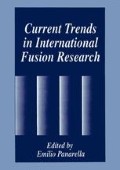Abstract
Plasma confinement schemes may be viewed as being related through evolutionary trends. The mirror machine represents an open magnetic geometry which was superseded by the closed magnetized toroidal geometries. Additionally, these toroidal geometries evolved by transference of coil current (Stellarators) to plasma currents (tokamaks). The Stellarator has essentially no plasma current, while the tokamak (as represented by ITER in Figure 1) has a major toroidal current. The Spheromak goes further and successfully incorporates a significant fraction of the poloidal current of the tokamak’s toroidal field coils as a plasma current.
Access this chapter
Tax calculation will be finalised at checkout
Purchases are for personal use only
Preview
Unable to display preview. Download preview PDF.
References
J. D. Barry,“Ball Lightning and Bead lightning,”Plenum, NY, (1980) ISBN 0-306-40272-6. (contains an 86 page bibliography).
D. L. Book, NRL Plasma Formulary, NRL 0084-4040, 1987.
M. N. Bussac, H. P. Furth, et al.,“Low-Aspect Ratio Limit of the Toroidal Reactor: The Spheromak,”IAEA CN-37, Innsbruck, 1978.
P. M. Koloc, “PLASMAK™ Star Power for Energy Intensive Space Applications” Fusion Technology, Vol 15 (1989), pp. 1136–1141
P. M. Koloc, “The PLASMAK™ Configuration and Ball Lightning,” Proc. First International Symposium on Ball Lightning, Tokyo, Japan, 1988. Published in Y. H. Ohtsuki (ed.), Science of Ball Lightning (Fire Ball). World, Teaneck, NJ, 1989.
P. M. Koloc, U.S. Patent No. 5,015,432, issued May, 1991
P. M. Koloc, U.S. Patent No. 4,891,180, issued January, 1990
J. R. Roth, “Ball Lightning: What Nature is Trying to Tell the Plasma Research Community”, First International Symposium on Evaluation of Current Trends in Fusion Research, Washington, D.C., 1994.
J. R. Roth, “Ball Lightning as a Route to Fusion Energy” Proc. 13th Symp. on Fusion Energy, Vol. II, IEEE Cat. No. 89CH2820-9 (1989), pp. 1407–11.
J. R. Roth, Introduction to Fusion Energy, Lincoln Rembrandt Publishing, Charlottesville, VA (1986), ISBN 0-935005-07-2.
S. Singer, The Nature of Ball Lightning, Plenum, NY (1971), ISBN 306-30494-5, [Schneidermann Photograph, 1933]
Z. Stekly, Plasma Jet Driven Inductive Efficiencies with Superconducting Coils, AVCO Everett Internal Report, 1964.
Author information
Authors and Affiliations
Editor information
Editors and Affiliations
Rights and permissions
Copyright information
© 1997 Springer Science+Business Media New York
About this chapter
Cite this chapter
Koloc, P.M. (1997). Fusion Implications of Free-Floating PlasmakTM Magnetoplasmoids. In: Panarella, E. (eds) Current Trends in International Fusion Research. Springer, Boston, MA. https://doi.org/10.1007/978-1-4615-5867-5_31
Download citation
DOI: https://doi.org/10.1007/978-1-4615-5867-5_31
Publisher Name: Springer, Boston, MA
Print ISBN: 978-1-4613-7690-3
Online ISBN: 978-1-4615-5867-5
eBook Packages: Springer Book Archive

